
Study of Safety and Efficacy of H-1337 in Subjects With Primary Open Angle Glaucoma or Ocular Hypertension...
Glaucoma Open-Angle PrimaryOcular HypertensionThe trial will evaluate the safety and efficacy of 3 dose regimens of H-1337 [0.6% twice daily (b.i.d.), 1.0% b.i.d. and 1.0% once in the morning (q.a.m.), and timolol maleate (0.5%, b.i.d.) in both eyes for 28 days.

IBS Titan™ Sirolimus-eluting Iron Bioresorbable Peripheral Scaffold System Clinical Trial
Infrapopliteal LesionsCritical Limb IschemiaThe goal of this prospective, multicentre, single arm clinical trial is to assess the safety and effectiveness of Sirolimus-eluting Iron Bioresorbable Peripheral Scaffold System (IBS Titan™) in treating patients with infrapopliteal arterial stenosis or occlusive disease. 100 participants will be implanted with IBS Titan™, and be followed up for 1-month, 6-month and 12-month after discharge.

The Effect of Chronic Remote Ischaemic Preconditioning on Blood Pressure in Older Adults
HypertensionVascular DiseasesThe purpose of this study is to assess whether remote ischaemic conditioning, applied chronically, improves vascular health in older adults

A Study For Treatment of Paroxysmal Atrial Fibrillation (PAF) With the OMNYPULSE Catheter and the...
Atrial FibrillationThe purpose of this study is to demonstrate safety and effectiveness of the ablation system (OMNYPULSE Bi-directional catheter and TRUPULSE generator) when used for isolation of the atrial pulmonary veins (PVs) in treatment of participants with paroxysmal atrial fibrillation (PAF).

First-in-man Study of the Cerebrovascular Interventional Procedural Control System
Acute Ischemic StrokeThe objective of this study the first human use of a new device in treatment of acute ischemic stroke, which to evaluate the feasibility, safety, and efficacy of the Cerebrovascular Interventional Procedural Control System.

Mirror Therapy Versus PNF on LE Function in Stroke
StrokeMany rehabilitation strategies are being implemented to treat stroke. Constraint-induced movement therapy and robotics are two potentially useful treatment options for rehabilitation. Range of motion exercises, PNF, mirror therapy is also used. Fitness training, high-intensity treatment, and repetitive-task training are all promising strategies that might help improve elements of gait. Repeated task training may also help with transfer functions

Evaluation of the Effectiveness and Safety of ABAStroke
StrokeThe aim of the project is to confirm the effectiveness and safety of the ABAStroke technology, which uses the principles of Applied Behavior Analysis (ABA) in the rehabilitation of cognitive deficits in patients after strokes. The study is comparative in nature, where a group of 100 patients will be included in this randomized study, divided equally into a study group and a control group. The purpose of the study is also to demonstrate that this non-invasive new rehabilitation technology based on the ABAStroke computer software supports the process of rehabilitation in the field of cognitive functions together with standard pharmacological therapy, including the possibility of using rehabilitation (as recommended by researchers and other doctors conducting rehabilitation of a patient after a stroke brain). ABAStroke can lead to improved cognitive functions (such as abstraction, short-term memory, visuospatial functions, executive functions, language, verbal fluency, allopsychic orientation, and attention) and is delivered via a mobile device app that can be used at home.

Platelet Function in Patients With Ischemic Stroke Treated With Anti-thrombotic or Thrombolytic...
Acute Ischemic StrokeAcute stroke afflicts nearly 700,000 patients in the US and is the number 3 cause of death. Only 2-9% of this large number is treated with t-PA if they arrive within 4.5 hours. An equally small percentage of patients with large vessel occlusion undergo thrombectomy. The thrombectomy patients may or may not receive t-PA. Some of these patients rarely receive intravenous GPIIB/IIIa inhibitors. Many lines of evidence suggest that GP IIb/IIIa inhibitors, a class of FDA approved potent platelet inhibitors that have been used extensively along with heparin for acute coronary syndromes (heart attacks) and unstable angina (chest pain), may be safe enough to give in these circumstances.

Cardiometabolic Effects of Dapagliflozin in Heart Failure With Reduced or Mildly Reduced Ejection...
Heart FailureReduced Ejection FractionGliflozins have demonstrated a beneficial effect in terms of incident heart failure and related events in patients with or without diabetes. The clinical trial ICARD is an exploratory study that aims to evaluate the cardiometabolic mechanistic effects on the myocardium of dapagliflozin in heart failure with reduced ejection fraction. Deep phenotyping of cardiac and vascular function will be performed using MRI. Myocardial tissue characterization will be based on MRI and FDG-PET for glucose metabolism assessment. Liver steatosis and fibrosis will simultaneously be assessed.

A Trail of Drug-coated Balloon Treating Below The Knee Arterial Diseases
Peripheral Artery DiseaseThis is a prospective, multicenter, randomized controlled trail using drug-coated balloon to treat below the knee arterial stenosis or occlusion.
